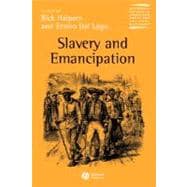
Note: Supplemental materials are not guaranteed with Rental or Used book purchases.
Purchase Benefits
Looking to rent a book? Rent Slavery and Emancipation [ISBN: 9780631217350] for the semester, quarter, and short term or search our site for other textbooks by Halpern, Rick; Dal Lago, Enrico. Renting a textbook can save you up to 90% from the cost of buying.
Enrico Dal Lago is Lecturer in American History at the National University of Ireland, Galway. He is the co-editor of The American South and the Italian Mezzogiorno: Essays in Comparative History (2002), and author of the forthcoming Southern Elites: American Planters and Southern Italian Noblemen, 1815–1865.
| Series Editor's Preface | xi | ||||
| Acknowledgements | xiii | ||||
| Introduction | 1 | (9) | |||
|
10 | (25) | |||
|
10 | (3) | |||
|
13 | (1) | |||
|
14 | (2) | |||
|
16 | (2) | |||
|
18 | (17) | |||
|
|||||
|
35 | (20) | |||
|
35 | (2) | |||
|
37 | (1) | |||
|
38 | (3) | |||
|
41 | (1) | |||
|
42 | (13) | |||
|
|||||
|
55 | (32) | |||
|
55 | (2) | |||
|
57 | (1) | |||
|
58 | (3) | |||
|
61 | (2) | |||
|
63 | (24) | |||
|
|||||
|
87 | (36) | |||
|
87 | (3) | |||
|
90 | (1) | |||
|
91 | (1) | |||
|
92 | (4) | |||
|
96 | (27) | |||
|
|||||
|
123 | (23) | |||
|
123 | (3) | |||
|
126 | (3) | |||
|
129 | (2) | |||
|
131 | (2) | |||
|
133 | (13) | |||
|
|||||
|
146 | (31) | |||
|
146 | (3) | |||
|
149 | (2) | |||
|
151 | (2) | |||
|
153 | (2) | |||
|
155 | (22) | |||
|
|||||
|
177 | (29) | |||
|
177 | (3) | |||
|
180 | (1) | |||
|
181 | (1) | |||
|
182 | (3) | |||
|
185 | (21) | |||
|
|||||
|
206 | (27) | |||
|
206 | (2) | |||
|
208 | (2) | |||
|
210 | (2) | |||
|
212 | (2) | |||
|
214 | (19) | |||
|
|||||
|
233 | (32) | |||
|
233 | (3) | |||
|
236 | (2) | |||
|
238 | (2) | |||
|
240 | (2) | |||
|
242 | (23) | |||
|
|||||
|
265 | (29) | |||
|
265 | (3) | |||
|
268 | (2) | |||
|
270 | (2) | |||
|
272 | (2) | |||
|
274 | (20) | |||
|
|||||
|
|||||
|
294 | (22) | |||
|
294 | (3) | |||
|
297 | (2) | |||
|
299 | (3) | |||
|
302 | (2) | |||
|
304 | (12) | |||
|
|||||
|
316 | (29) | |||
|
316 | (3) | |||
|
319 | (3) | |||
|
322 | (2) | |||
|
324 | (2) | |||
|
326 | (19) | |||
|
|||||
|
345 | (32) | |||
|
345 | (3) | |||
|
348 | (2) | |||
|
350 | (2) | |||
|
352 | (2) | |||
|
354 | (23) | |||
|
|||||
|
377 | (24) | |||
|
377 | (3) | |||
|
380 | (2) | |||
|
382 | (3) | |||
|
385 | (2) | |||
|
387 | (14) | |||
|
|||||
| Index | 401 |
The New copy of this book will include any supplemental materials advertised. Please check the title of the book to determine if it should include any access cards, study guides, lab manuals, CDs, etc.
The Used, Rental and eBook copies of this book are not guaranteed to include any supplemental materials. Typically, only the book itself is included. This is true even if the title states it includes any access cards, study guides, lab manuals, CDs, etc.